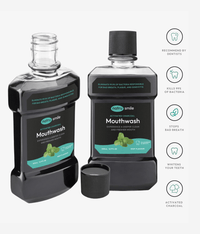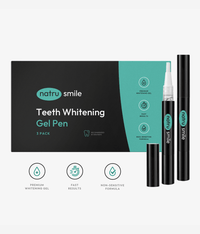
All products are certified by dental expert Dr. Greg Grillo
Cavities, or tooth decay, remain among the most ignored dental problems despite people being aware of its consequences. According to the CDC, 1 in 4 adults has at least one cavity. Although many circumstances influence people's decisions not to receive treatment, the reality is that tooth decay can lead to more serious dental issues if left untreated.
Therefore, it is critical to learn the stages of tooth decay, the best tooth decay treatment, and, more importantly, prevention tips. Let this guide provide you with the information you need to get started.
What Is Tooth Decay: Overview
Tooth decay is a process that destroys the tooth, starting from the enamel, which is the protective layer of teeth. It begins when bacteria-rich plaque accumulates in your mouth and forms acid. This acid breaks down the minerals in tooth enamel, leading to cavities or holes in your teeth.
If left alone, tooth decay can cause more severe dental issues, like tooth loss and gum disease. Since treatments for serious dental issues can be expensive and painful, it is vital to be proactive with your oral health and treat cavities in their early stages.
Stages Of Tooth Decay
Tooth decay is a slow process that can take months or years to develop if left untreated. Knowing its stages can help you determine when to seek treatment and how severe the damage is.
Stage 1: Initial Demineralization
Initial demineralization occurs when the bacteria in our mouths produce acids that cause the enamel on our teeth to start breaking down. The acids come from plaque and food particles that are left on teeth after eating.
As these substances mix with saliva in our mouths, they create an acidic environment that causes minerals like calcium and phosphate to be pulled out of the enamel. You can see signs of this demineralization by looking for white spots on your teeth.
How To Reverse Tooth Decay In This Stage
You can fix a cavity at home if you catch it this early, and that’s by adopting proper and regular oral hygiene habits.
Such habits include brushing your teeth at least twice a day with fluoride toothpaste, proper daily flossing (ensuring all plaque is removed), and using fluoride mouthwash. Fluoride helps remineralize the enamel, strengthening and protecting your teeth from further decay.
Stage 2: Enamel Decay
If initial demineralization is not treated, a tooth's enamel will break down further, causing enamel decay. As bacteria produce more acid on the surface of the teeth, it starts to dissolve and weaken the enamel, creating microscopic openings. These holes are characterized by tiny brown or black spots on the teeth.
How To Reverse Tooth Decay In This Stage
Since holes have already formed in the enamel, correcting the damage simply by brushing and flossing is impossible.
To fix tooth decay at this stage, you'll need to have your dentist perform fillings, which involve the removal of decayed material and replacing it with a composite filling. Your dentist may also recommend fluoride treatments, sealants, or other therapies to protect your teeth from further damage.
However, it's important to note that not all dark spots on your teeth are necessarily cavities. It’s best to get these spots checked by a dentist immediately, as some may indicate other dental issues, such as discoloration.
In the latter case, you can treat it with at-home teeth whitening kits or even natural teeth whitening methods like baking soda.
Stage 3: Dentin Decay
Dentin is the next layer of the tooth below the enamel and is composed of a material softer than enamel. If decay reaches this layer, you will start to feel a dull ache when eating or drinking something hot or cold.
This is due to bacteria breaking down and softening the dentin, which exposes nerve endings that are normally protected by enamel.
How To Reverse Tooth Decay In This Stage
The best way to reverse tooth decay in this stage is by having a dentist fill the affected area with either an amalgam or composite resin. This material will protect the remaining dentin and prevent further decaying of your teeth.
Stage 4: Pulp Damage
Pulp damage occurs when bacteria have reached the innermost layer of a tooth, called the pulp. The pulp contains blood vessels, nerves, and other important tissues that provide nutrients to the tooth. When these tissues become infected, they can cause pain and swelling in the area around the affected tooth.
If left untreated for too long, the infection can spread through your bloodstream or even cause an abscessed tooth--a pocket of pus at the root of a damaged tooth.
How To Reverse Tooth Decay In This Stage
If the pulp of your tooth is damaged, you'll need a root canal procedure to remove it and save the affected tooth. During this procedure, your dentist will drill into your tooth to access the infected pulp and then remove it.
Then they'll fill in the space with a special material that replaces the missing tissue. Afterward, you may need a crown to protect your restored tooth from further damage.
Stage 5: Abscess
An abscess is a pocket of pus that forms when the body tries to fight off an infection. In the case of tooth decay, it happens when bacteria have been allowed to spread deep into the tissue around the tooth and cause an infection.
This can be painful and, if left untreated, can damage other parts of your mouth and even spread throughout your body.
The abscess will appear as a swollen area near or on the affected tooth, usually accompanied by throbbing pain and sensitivity to hot and cold temperatures.
How To Reverse Tooth Decay In This Stage
At this stage, the only way to reverse tooth decay is through a root canal procedure.
During this procedure, your dentist will drain the abscess, remove any infected tissue, and replace it with a filling material. Sometimes, the tooth may need to be extracted and replaced with an implant.
Once treated, the dentist may prescribe a course of antibiotics to help prevent any further infection.
Before And After Tooth Decay Treatment
Tips To Prevent Tooth Decay
Common treatments for tooth decay can be relatively costly. Based on a 2020 survey, the average cost of a filling is $147.82, while a crown procedure costs at least $1,288.07. These figures prove why prevention is the best way to avoid dental problems.
Here are some tips for preventing tooth decay:
Brush Your Teeth At Least Twice A Day
Brushing your teeth at least twice a day helps to remove plaque, the sticky film of bacteria that builds up on your teeth. Plaque produces acids that attack and break down tooth enamel, causing cavities.
Brushing also helps remove food particles from between the teeth, where they can accumulate and cause further damage if left unaddressed.
Clean Between Your Teeth With Dental Floss
Brushing your teeth should always be paired with daily flossing because flossing helps remove plaque and bacteria between your teeth that your toothbrush can’t reach. Untouched bacteria build up on the surface of the teeth and breaks down the enamel. By flossing regularly, you remove those bacteria and protect yourself from tooth decay.
See Your Dentist Regularly
Regular dentist visits help prevent tooth decay because your dentist will identify any areas of the teeth at risk for developing cavities.
The dentist can assess your risk for decay and provide advice on reducing it, such as brushing twice a day and flossing daily or using fluoride treatments. If a cavity is caught early enough, the dentist may be able to repair it before more severe damage is done.
Regular visits also help keep your gums healthy - if plaque builds up around the teeth and isn't removed by brushing, it could lead to gum disease, which can cause inflammation, pain, and even loss of teeth.
Limit Sweets
Sugary and starchy products are food to avoid, as they create an ideal environment for bacteria to grow in your mouth. Bacteria feed on these types of food, producing acids that attack the enamel on your teeth.
Over time, this causes demineralization, which, as we’ve established, can lead to cavities. If you reduce the amount of sugar in your diet, then there are fewer substances available for bacteria to feed on and, therefore, less acid produced.
Rinse Daily With A Fluoride-Containing Mouthwash
Aside from brushing, rinsing with fluoride mouthwash is another way to apply fluoride to your teeth and help prevent tooth decay. Fluoride is a mineral that helps protect against the acid produced by bacteria in our mouths which can lead to cavities.
When fluoride is applied directly to teeth, it forms a protective shield around them and helps keep the enamel strong, making it less susceptible to damage from acids or plaque.
Drink Water From The Tap
Public tap water in the US is fluoridated, meaning fluoride has been added to the water. As we’ve mentioned, fluoride helps prevent tooth decay by making teeth more resistant to acid attacks in the mouth. According to observational studies, water fluoridation reduces the risk of decay in children by 35%.
Eat Nutritious And Balanced Meals
Healthy meals provide the body with essential vitamins, minerals, and other nutrients that strengthen teeth and make them more resistant to bacteria. For instance, eating foods high in calcium (such as dairy) helps build strong enamel.
Additionally, avoiding sugary foods limits the amount of sugar bacteria can feed on. When there is less sugar present in your mouth, it reduces the chances of developing cavities and other decay-causing issues.
Avoid Snacking
When you frequently snack throughout the day, this keeps your teeth exposed to acid for a longer period of time than if you just ate at meal times. Therefore, avoiding snacks helps reduce exposure to harmful acids that cause bad tooth decay.
Snacks also typically contain sugar. So avoiding snacks helps reduce the amount of sugar that comes into contact with your teeth.
Ask Your Dentist About Dental Sealants
Dental sealants provide a barrier between your teeth and bacteria. They are usually made of a plastic material that is painted onto the chewing surfaces of the back teeth (molars and pre-molars).
This helps prevent food and plaque from getting stuck in those hard-to-reach places, which can lead to molar tooth decay. The sealant acts as an extra layer of protection against cavities, helping to improve your smile for years to come!
Is Tooth Decay Reversible?
In short, yes - tooth decay is reversible in its early stages. If you catch it soon enough and take the necessary steps to treat it, you can reverse the damage done to your teeth.
The best way to do this is by brushing twice a day with fluoride toothpaste, flossing regularly, and seeing your dentist for regular check-ups and cleanings.
However, if the decay has progressed too far or caused an infection of the root of the tooth, then it may require more extensive treatments such as fillings or even extraction.
How Long Does It Take To Reverse Tooth Decay?
The answer depends on how much decay there is and the type of treatment you receive. In general, it can take anywhere from a few weeks to several months for tooth decay to be reversed.
During this time, your dentist may recommend treatments such as fillings, crowns, or root canals to restore your teeth back to health. You will also need to practice good oral hygiene habits at home to keep your teeth healthy and prevent further damage.
How To Stop Tooth Decay From Spreading?
To stop tooth decay from spreading, you should practice good oral hygiene habits, such as brushing your teeth twice a day with fluoride toothpaste. Flossing once a day and using an antiseptic mouthwash can also help keep your mouth clean and free of plaque and bacteria that cause decay.
Also, make sure to visit the dentist every six months for a professional cleaning and check-up. If caught early, most cavities can be treated before they get worse.
It is important to avoid sugary snacks or drinks throughout the day since sugar helps feed bacteria which causes decay. Eating healthy foods like fruits and vegetables can also help keep your teeth healthy.
What Does A Decaying Tooth Look Like?
A decaying tooth can look different for everyone. Generally, it will appear darker than the other teeth and may have areas of discoloration or brownish spots. Over time, it can begin to erode away, leaving a small hole in the tooth's surface.
If ignored, it could even cause the entire tooth to break apart. In extreme cases, you may be able to see pieces of tooth decay on your tongue or in your mouth when you eat something sweet or acidic.
How Do I Stop My Teeth From Decaying?
Maintaining good dental hygiene habits is the best way to prevent tooth decay. This includes brushing and flossing regularly and seeing your dentist for periodic cleanings and check-ups.
Avoiding sugary foods and drinks can also help reduce the risk of cavities. You should also avoid smoking or using other tobacco products as they can increase the risk of gum disease, which can lead to tooth decay.
Is Tooth Decay Serious?
Yes, tooth decay is a serious issue. If not treated in time, it can lead to pain, infection, and even tooth loss.
If you allow tooth decay to continue, the bacteria that cause the decay can spread throughout your mouth, causing more cavities and potentially leading to gum disease or other oral health issues like bad breath.
Early diagnosis and treatment of any dental problem is key for preventing more serious problems down the road, so make sure you visit your dentist regularly and take good care of your teeth.
Why Are My Teeth Decaying So Fast?
Unhealthy habits like not brushing and flossing regularly, consuming sugary drinks or snacks, smoking, and eating acidic foods can all contribute to tooth decay. All these habits invite bacteria to build up on the surface of your teeth and allow acids to weaken the enamel.
Additionally, some people are more prone to tooth decay due to genetics or environmental factors, like dry mouth. If you think your teeth are decaying too quickly, it's best to make an appointment with a dentist for a check-up.
Can Teeth Grow Back After Decay?
Unfortunately, no, teeth cannot grow back after decay. Once a tooth's enamel is damaged, it cannot be repaired naturally. The only way to repair the damage caused by decay is to have a dentist fill or replace the affected tooth with an artificial material such as a crown.
That’s why it’s important to take good care of your teeth and get regular check-ups so that any problems can be detected early and treated before they cause permanent damage.
At What Age Do Teeth Start Decaying?
There is no exact age at which teeth start decaying. Cavities can form as soon as a child's first tooth appears, so it is important to start caring for your teeth early in life. Records show 23% of children ages 2 to 5 years have had cavities.
Poor oral hygiene and sugary foods are the biggest culprits in decaying teeth, but certain medical conditions, medications, or genetics can also make you more prone to cavities.
Is It Painful To Have Tooth Decay?
Yes, having tooth decay can be painful. When a cavity first forms, you may experience sensitivity to hot and cold foods or drinks. As the cavity gets bigger and deeper, it can cause pain when biting down on food or even when your mouth is at rest.
If left untreated, the infection from the decay can spread to other parts of your mouth, resulting in more severe pain. It’s critical to see a dentist if you think you have a cavity so that it can be treated before it becomes too painful or causes further damage.
The Bottom Line
Tooth decay is a serious dental problem that can lead to more severe issues. Fortunately, it is a progressive condition, which means it can be prevented and treated if caught early enough.
By adopting habits that reduce your risk of tooth decay, such as brushing and flossing regularly, eating a healthy diet, and visiting the dentist periodically, you can reduce your chances of developing cavities or needing more serious treatments down the line.
If you do develop tooth decay, know that effective treatment methods are available to restore your teeth to their former glory. With the proper care and attention, you can keep your teeth in tip-top shape and your smile bright!









